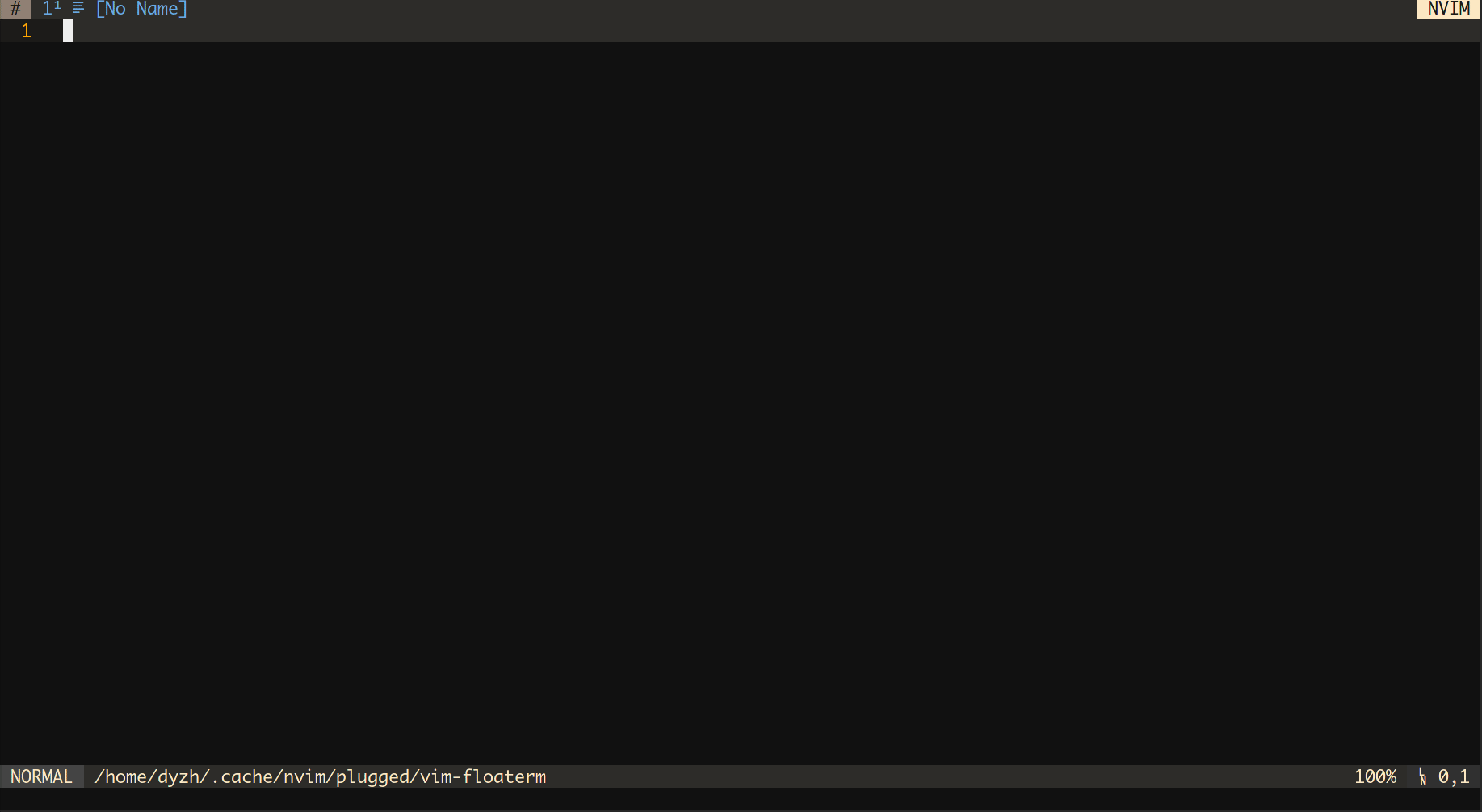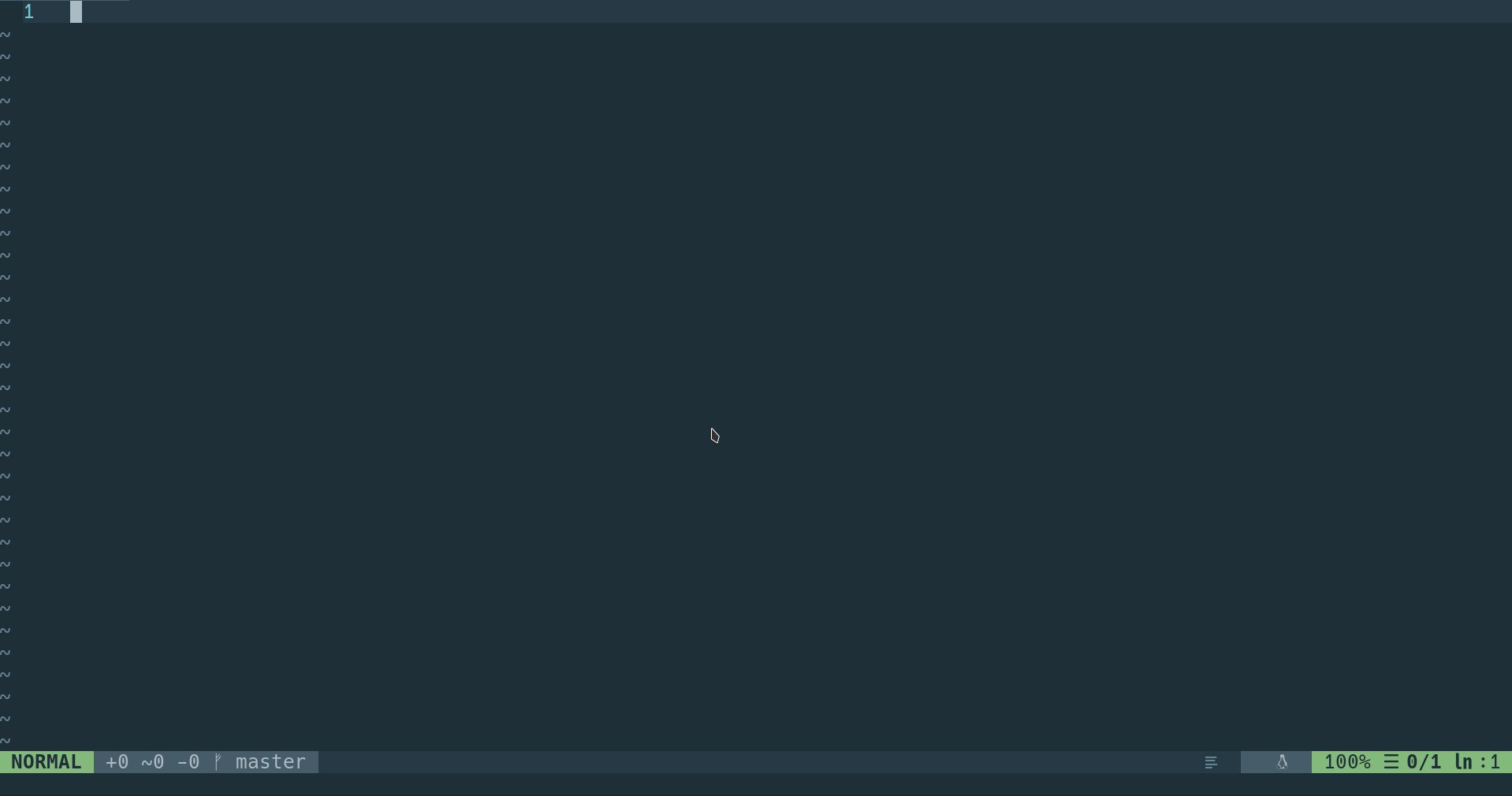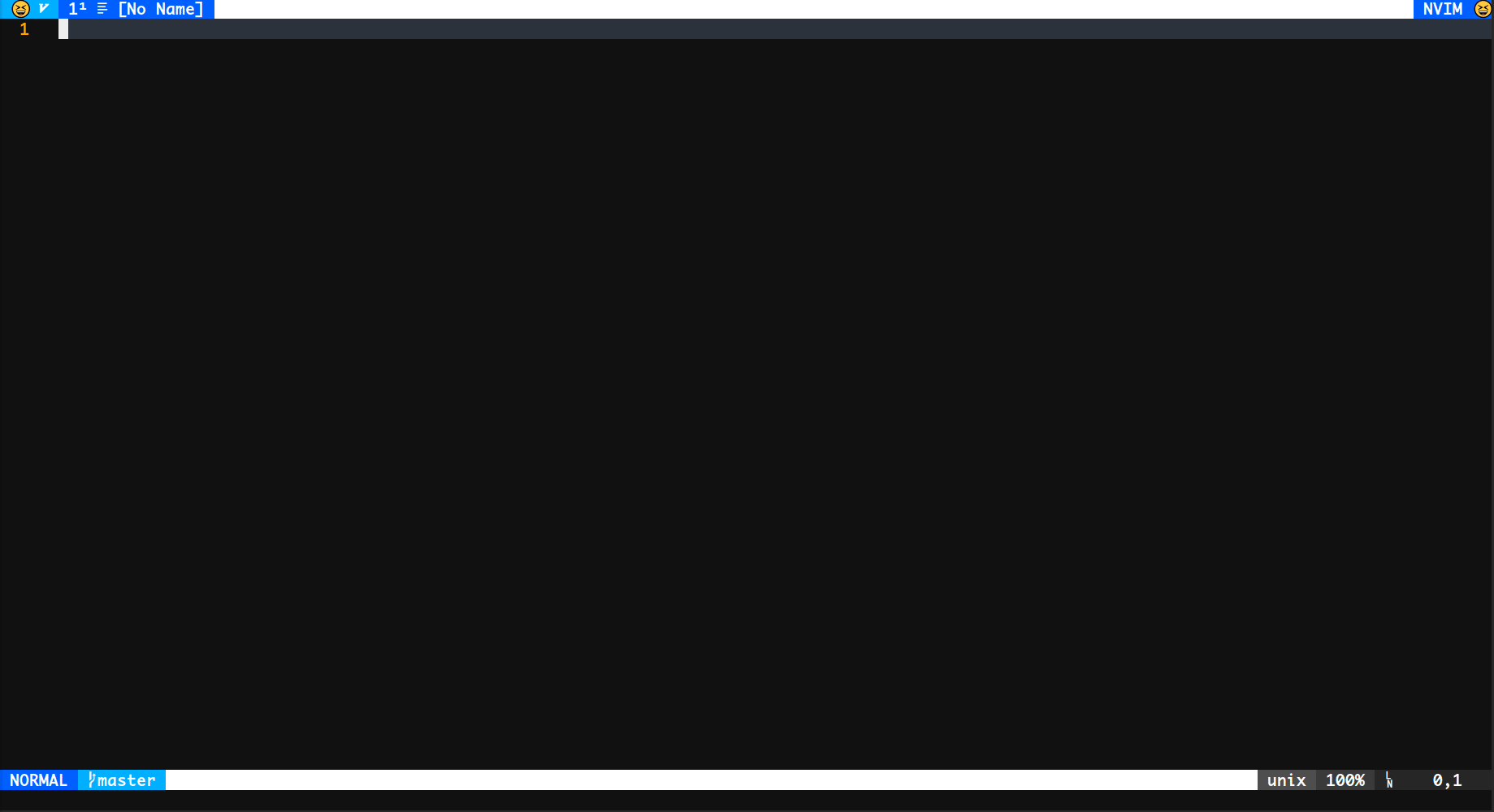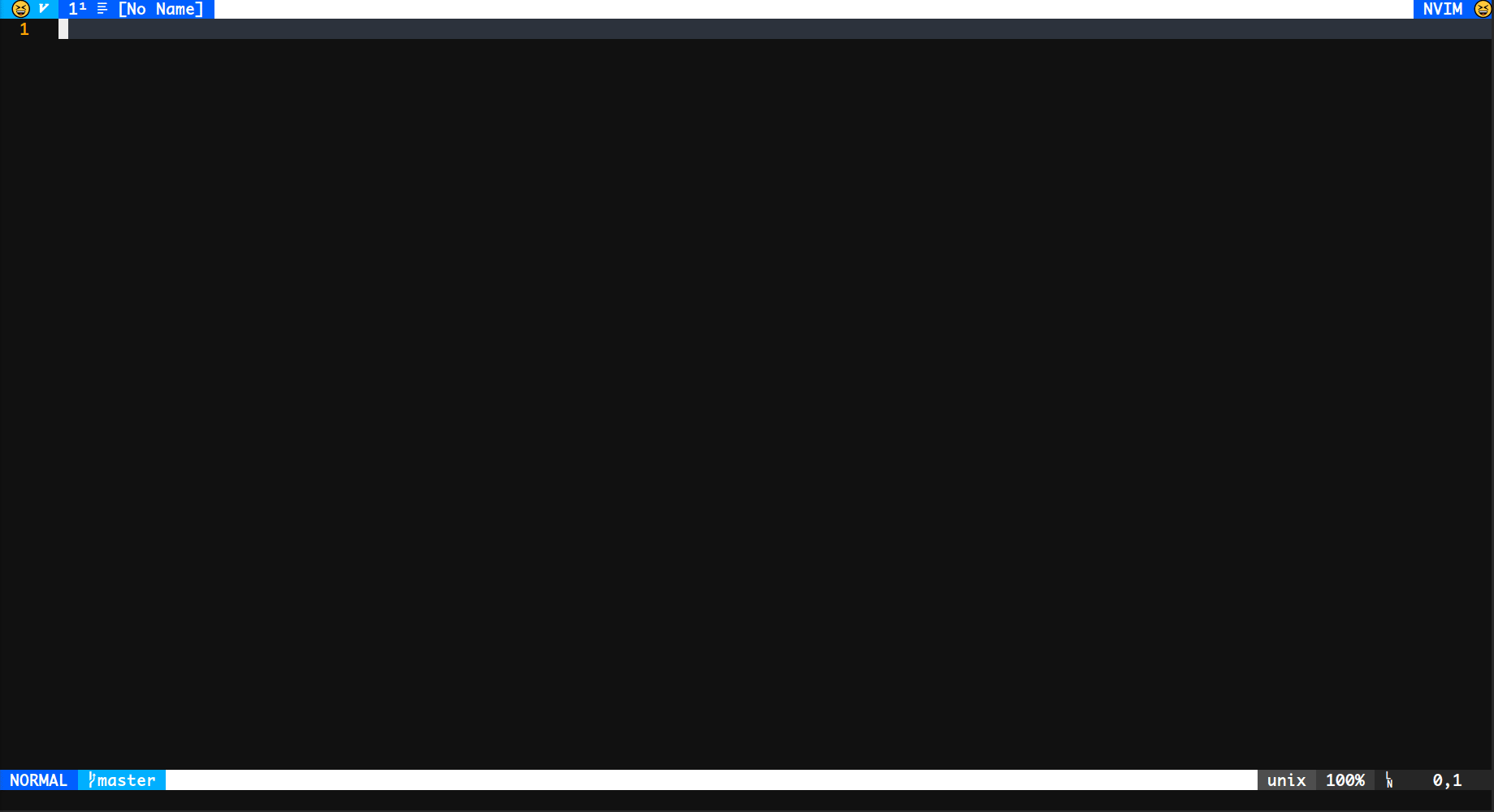Use (neo)vim terminal in the floating/popup window.
- Features
- Requirements
- Installation
- Get started
- Advanced Topics
- Contributing
- FAQ
- Breaking changes
- Related projects
- Credits
- License
Features
- Support neovim floatwin and vim8 popupwin
- Manage multiple terminal instances
- Customizable terminal window style
- Switch/preview floating terminal buffers using fuzzy-finder plugins such as denite.nvim or fzf, etc.
- Use with other external command-line tools(ranger, fzf, ripgrep etc.)
- Use as a custom task runner for asynctasks.vim or asyncrun.vim
Requirements
- Vim or neovim with
terminalfeature
Installation
- packer.nvim
use 'voldikss/vim-floaterm'
- vim-plug
Plug 'voldikss/vim-floaterm'- dein.nvim
call dein#add('voldikss/vim-floaterm')Get Started
Use :FloatermNew to open a terminal window, use :FloatermToggle to
hide/reopen that. The filetype of the terminal buffer is floaterm.
If you've opened multiple floaterm instances, they will be attached to a
double-circular-linkedlist. Then you can use :FloatermNext or
: FloatermPrev to switch between them.
yarn watch) inside the builtin terminal
would probably slowdown your operation. It's recommended to put them into the
external terminals.
Commands
:FloatermNew[!] [options] [cmd] Open a floaterm window.
- If
!is given, executecmdin$SHELL. Try:FloatermNew pythonand: FloatermNew! pythonto learn about the difference. - If execute without
cmd, open$SHELL. - The
optionsis formed as--key[=value], it is used to specify local attributes of a specific floaterm instance. Note that in order to input space, you have to form it as\followed by space, and\must be typed as\\cwdworking directory that floaterm will be opened at. Accepts a path, the literal<root>which represents the project root directory, and the literal<buffer>which specifies the directory of the active buffernamename of the floatermsilentIf--silentis given, spawn a floaterm but not open the window, you may toggle it afterwardsdisposableIf--disposableis given, the floaterm will be destroyed once it is hidden.titleseeg:floaterm_titlewidthseeg:floaterm_widthheightseeg:floaterm_heightopenerseeg:floaterm_openerwintypeseeg:floaterm_wintypepositionseeg:floaterm_positionautocloseseeg:floaterm_autoclosebordercharsseeg:floaterm_bordercharstitlepositionseeg:floaterm_titleposition
- This command basically shares the consistent behaviors with the builtin
:terminal:- The special characters(
:help cmdline-special) such as%and<cfile>will be auto-expanded, to get standalone characters, use\followed by the corresponding character(e.g.,\%). - Note that
<bar>(i.e.,|) will be seen as an argument of the command, therefore it can not be followed by another Vim command.
- The special characters(
- If execute this command with a range, i.e.,
'<,'>:FloatermNew ..., the selected lines will be sent to the created floaterm. For example, see python repl use case below. - Use
<TAB>to get completion.
For example, the command
:FloatermNew --height=0.6 --width=0.4 --wintype=float --name=floaterm1 --position=topleft --autoclose=2 ranger --cmd="cd ~"will open a new floating/popup floaterm instance named floaterm1 running
ranger --cmd="cd ~" in the topleft corner of the main window.
The following command allows you to compile and run your C code in the floaterm window:
:FloatermNew --autoclose=0 gcc % -o %< && ./%<:FloatermPrev Switch to the previous floaterm instance
:FloatermNext Switch to the next floaterm instance
:FloatermFirst Switch to the first floaterm instance
:FloatermLast Switch to the last floaterm instance
:FloatermUpdate [options] Update floaterm window attributes(height, width, etc.).
- The
optionsis the same as in:FloatermNew(except--silent). - Use
<TAB>to get completion.
:[N]FloatermToggle[!] [floaterm_name] Open or hide the floaterm window.
- If
Nis given, toggle the floaterm whose buffer number isN - If
floaterm_nameis given, toggle the floaterm instance whosenameattribute isfloaterm_name. Otherwise create a new floaterm namedfloaterm_name. - Use
<TAB>to get completion. - If
!is given, toggle all floaterms (:FloatermHide!or: FloatermShow!)
:[N]FloatermShow[!] [floaterm_name] Show the current floaterm window.
- If
Nis given, show the floaterm whose buffer number isN - If
floaterm_nameis given, show the floaterm namedfloaterm_name. - If
!is given, show all floaterms (If multiple floaterms have the same position attribute, only one of them will be show)
:[N]FloatermHide[!] [floaterm_name] Hide the current floaterms window.
- If
Nis given, hide the floaterm whose buffer number isN - If
floaterm_nameis given, show the floaterm namedfloaterm_name. - If
!is given, hide all floaterms
:[N]FloatermKill[!] [floaterm_name] Kill the current floaterm instance
- If
Nis given, kill the floaterm whose buffer number isN - If
floaterm_nameis given, kill the floaterm instance namedfloaterm_name. - If
!is given, kill all floaterms
:FloatermSend[!] [--name=floaterm_name] [cmd] Send command to a job in floaterm.
- If
--name=floaterm_nameis given, send lines to the floaterm instance whosenameisfloaterm_name. Otherwise use the current floaterm. - If
cmdis given, it will be sent to floaterm and selected lines will be ignored. - This command can also be used with a range, i.e.,
'<,'>:FloatermSend [--name=floaterm_name]to send selected lines to a floaterm.- If
cmdis given, the selected lines will be ignored. - If use this command with a
!, i.e.,'<,'>:FloatermSend! [--name=floaterm_name]the common white spaces in the beginning of lines will be trimmed while the relative indent between lines will still be kept.
- If
- Use
<TAB>to get completion. - Examples
:FloatermSend " Send current line to the current floaterm (execute the line in the terminal) :FloatermSend --name=ft1 " Send current line to the floaterm named ft1 :FloatermSend ls -la " Send `ls -la` to the current floaterm :FloatermSend --name=ft1 ls -la " Send `ls -la` to the floaterm named ft1 :23FloatermSend ... " Send the line 23 to floaterm :1,23FloatermSend ... " Send lines between line 1 and line 23 to floaterm :'<,'>FloatermSend ... " Send lines selected to floaterm(visual block selection are supported) :%FloatermSend ... " Send the whole buffer to floaterm
Options
g:floaterm_shell
Type String. Default: &shell
g:floaterm_title
Type String. Show floaterm info(e.g., 'floaterm: 1/3' implies there are 3
floaterms in total and the current is the first one) at the top left corner of
floaterm window.
Default: 'floaterm: $1/$2'($1 and $2 will be substituted by 'the index of
the current floaterm' and 'the count of all floaterms' respectively)
Example: 'floaterm($1|$2)'
g:floaterm_wintype
Type String. 'float'(nvim's floating or vim's popup) by default. Set it to
'split' or 'vsplit' if you don't want to use floating or popup window.
g:floaterm_width
Type Number (number of columns) or Float (between 0 and 1). If Float,
the width is relative to &columns.
Default: 0.6
g:floaterm_height
Type Number (number of lines) or Float (between 0 and 1). If Float, the
height is relative to &lines.
Default: 0.6
g:floaterm_position
Type String. The position of the floating window. Available values:
-
If
wintypeissplit/vsplit:'leftabove','aboveleft','rightbelow','belowright','topleft','botright'. Default:'botright'.It's recommended to have a look at those options meanings, e.g.
:help :leftabove. -
If
wintypeisfloat:'top','bottom','left','right','topleft','topright','bottomleft','bottomright','center','auto'(at the cursor place). Default:'center'
In addition, there is another option 'random' which allows to pick a random
position from above when (re)opening a floaterm window.
g:floaterm_borderchars
Type String. 8 characters of the floating window border (top, right, bottom,
left, topleft, topright, botright, botleft).
Default: ─│─│┌┐┘└
g:floaterm_rootmarkers
Type List of String. Markers used to detect the project root directory for --cwd=<root>
Default: ['.project', '.git', '.hg', '.svn', '.root']
g:floaterm_giteditor
Type Boolean. Whether to override $GIT_EDITOR in floaterm terminals so git commands can
open open an editor in the same neovim instance. See git for details.
Default: v:true
g:floaterm_opener
Type String. Command used for opening a file in the outside nvim from within :terminal.
Available: 'edit', 'split', 'vsplit', 'tabe', 'drop' or
user-defined commands
Default: 'split'
g:floaterm_autoclose
Type Number. Whether to close floaterm window once the job gets finished.
0: Always do NOT close floaterm window1: Close window if the job exits normally, otherwise stay it with messages like[Process exited 101]2: Always close floaterm window
Default: 1.
g:floaterm_autohide
Type Number. Whether to hide previous floaterms before switching to or
opening a another one.
0: Always do NOT hide previous floaterm windows1: Only hide those whose position (b:floaterm_position) is identical to that of the floaterm which will be opened2: Always hide them
Default: 1.
g:floaterm_autoinsert
Type Boolean. Whether to enter Terminal-mode after opening a floaterm.
Default: v:true
g:floaterm_titleposition
Type String. The position of the floaterm title.
Available: 'left', 'center', 'right'.
Default: 'left'
Keymaps
This plugin doesn't supply any default mappings. Here are the configuration examples.
" Configuration example
let g:floaterm_keymap_new = '<F7>'
let g:floaterm_keymap_prev = '<F8>'
let g:floaterm_keymap_next = '<F9>'
let g:floaterm_keymap_toggle = '<F12>'You can also use other keys as shown below:
let g:floaterm_keymap_new = '<Leader>ft'All options for the mappings are listed below:
g:floaterm_keymap_newg:floaterm_keymap_prevg:floaterm_keymap_nextg:floaterm_keymap_firstg:floaterm_keymap_lastg:floaterm_keymap_hideg:floaterm_keymap_showg:floaterm_keymap_killg:floaterm_keymap_toggle
Note that the key mappings are set from the plugin/floaterm.vim,
so if you are using on-demand loading feature provided by some plugin-managers,
the keymap above won't take effect(:help load-plugins). Then you have to
define the key bindings by yourself. For example,
nnoremap <silent> <F7> :FloatermNew<CR>
tnoremap <silent> <F7> <C-\><C-n>:FloatermNew<CR>
nnoremap <silent> <F8> :FloatermPrev<CR>
tnoremap <silent> <F8> <C-\><C-n>:FloatermPrev<CR>
nnoremap <silent> <F9> :FloatermNext<CR>
tnoremap <silent> <F9> <C-\><C-n>:FloatermNext<CR>
nnoremap <silent> <F12> :FloatermToggle<CR>
tnoremap <silent> <F12> <C-\><C-n>:FloatermToggle<CR>Highlights
There are two highlight-groups to specify the color of floaterm (also the
border color if g: floaterm_wintype is 'float') window.
To customize, use hi command together with the colors you prefer.
" Configuration example
" Set floaterm window's background to black
hi Floaterm guibg=black
" Set floating window border line color to cyan, and background to orange
hi FloatermBorder guibg=orange guifg=cyanBesides, there is a neovim only highlight group which can be used to configure
no-current-focused window(:help NormalNC).
" Configuration example
" Set floaterm window foreground to gray once the cursor moves out from it
hi FloatermNC guifg=grayAutocmd
autocmd User FloatermOpen " triggered after opening a new/existed floatermAdvanced Topics
Use with command line tools
The following cases should work both in Vim and NeoVim unless otherwise specifically noted.
floaterm
Normally if you run vim/nvim somefile.txt within the builtin terminal, you
would get another nvim/vim instance running in the subprocess.
Floaterm, which is
a builtin script in this plugin, allows you to open files from within : terminal
without starting a nested nvim. To achieve that, just literally replace
vim/nvim with floaterm, e.g. floaterm somefile.txt
P.S.
- #208
describes how to use
gfin the floating terminal window. floatermis too long to type? set alias in yourbashrc, e.g.alias f=floaterm- For configurable open action, refer to g:floaterm_opener
git
Execute git commit in the terminal window without starting a nested vim/nvim.
Refer to g:floaterm_giteditor to disable this behavior.
Refer to g:floaterm_opener for configurable open action
fzf
This plugin has implemented a wrapper
for fzf command. So it can be used as a tiny fzf plugin.
Try :FloatermNew fzf or even wrap this to a new command like this:
command! FZF FloatermNew fzfripgrep
Requirements:
This plugin has implemented a wrapper
for rg command.
Try :FloatermNew rg or create yourself a new command like this:
command! Rg FloatermNew --width=0.8 --height=0.8 rgor map via .vimrc
" Hotkey: \ + rg
nmap <leader>rg :Rg<CR>Demo
You can use Alt-A to select all files and Alt-D to deselect them. Use Ctrl-/ to toggle preview.
broot
This plugin has implemented a wrapper for broot.
Try :FloatermNew broot or create yourself a new command like this:
command! Broot FloatermNew --width=0.8 --height=0.8 brootfff
There is also an fff wrapper
Try :FloatermNew fff or define a new command:
command! FFF FloatermNew fffnnn
There is also an nnn wrapper
Try :FloatermNew nnn or define a new command:
command! NNN FloatermNew nnnxplr
There is also an xplr wrapper
Try :FloatermNew xplr or define a new command:
command! XPLR FloatermNew xplrlf
There is also an lf wrapper. It is recommened to use lf.vim which is an lf wrapper with more features (Overriding netrw, Lfcd, etc.).
Try :FloatermNew lf or define a new command:
command! LF FloatermNew lfranger
This plugin can also be a handy ranger plugin since it also has a ranger wrapper
Try :FloatermNew ranger or define a new command:
command! Ranger FloatermNew rangervifm
There is also a vifm wrapper
Try :FloatermNew vifm or define a new command:
command! Vifm FloatermNew vifmlazygit
Furthermore, you can also use other command-line programs, such as lazygit, htop, ncdu, etc.
Use lazygit for instance:
python
Use :FloatermNew python to open a python shell. After that you can use
: FloatermSend to send lines to the Python interactive shell.
Or you can just select lines and execute :'<,'>FloatermNew --wintype=split python, then the
selected lines will be sent and executed once a python repl floaterm window is
opened.
This can also work for other languages which have interactive shells, such as lua, node, etc.
Use with other plugins
vim-clap
Use vim-clap to switch/preview floating terminal buffers.
Install clap-floaterm and try :Clap floaterm
denite.nvim
Use denite to switch/preview/open floating terminal buffers.
Install denite-floaterm and try :Denial floaterm
coc.nvim
Use CocList to switch/preview/open floating terminal buffers.
Install coc-floaterm and try :CocList floaterm
fzf
Install fzf-floaterm and try :Floaterms
LeaderF
Install LeaderF-floaterm and try :Leaderf floaterm
asynctasks.vim | asyncrun.vim
This plugin can be a runner for asynctasks.vim or asyncrun.vim. See asyncrun.extra for the installation and usage.
How to define more wrappers
The wrapper script must be located in autoload/floaterm/wrapper/ directory,
e.g., autoload/floaterm/wrapper/fzf.vim.
There are two ways for a command to be spawned:
-
To be executed after spawning
$SHELL. Here is the old implementation of fzf wrapperfunction! floaterm#wrapper#fzf#(cmd, jobopts, config) abort return [v:true, 'floaterm $(fzf)'] endfunction
The code above returns a list.
floaterm $(fzf)is the command to be executed.v:truemeans the command will be executed after the&shellstartup. -
To be executed through
termopen()/term_start()function, in that case, a callback option can be provided. See fzf wrapperfunction! floaterm#wrapper#fzf#(cmd, jobopts, config) abort let s:fzf_tmpfile = tempname() let cmd = a:cmd . ' > ' . s:fzf_tmpfile let a:jobopts.on_exit = funcref('s:fzf_callback') return [v:false, cmd] endfunction function! s:fzf_callback(...) abort if filereadable(s:fzf_tmpfile) let filenames = readfile(s:fzf_tmpfile) if !empty(filenames) if has('nvim') call floaterm#window#hide(bufnr('%')) endif let locations = [] for filename in filenames let dict = {'filename': fnamemodify(filename, ':p')} call add(locations, dict) endfor call floaterm#util#open(locations) endif endif endfunction
In the example above, after executing
:FloatermNew fzf, functionfloaterm#wrapper#fzf#will return[v:false, 'fzf > /tmp/atmpfilename'].
Here
v:falsemeanscmdfzf > /tmp/atmpfilename
will be passed through
termopen()(neovim) orterm_start()(vim). As the result, an fzf interactive will be opened in a floaterm window.When user picks a file using
ENTER, fzf exits and the filepath will be written in/tmp/atmpfilenameands:fzf_callback()will be invoked to open the file. Note that the functions: fzf_callback()is registered bylet a:jobopts.on_exit = funcref('s:fzf_callback')
The variable
a:joboptsin the above code will be eventually passed totermopen()(neovim) orterm_start()(vim). For more info, see:help jobstart-options(neovim) or:help job-options(vim)
How to write sources for fuzzy finder plugins
Function floaterm#buflist#gather() returns a list contains all the floaterm buffers.
Function floaterm#terminal#open_existing({bufnr}) opens the floaterm whose buffer number is {bufnr}.
For reference, see floaterm source for LeaderF.
Contributing
- Improve the documentation
- Help resolve issues labeled as help wanted
FAQ
https://github.com/voldikss/vim-floaterm/issues?q=label%3AFAQ
Breaking Changes
https://github.com/voldikss/vim-floaterm/issues?q=label%3A%22breaking+change%22
Related projects
Credits
License
MIT




















